Classification Scheme for the Three-Point Dubins Problem
Abstract
1. Introduction
2. Problem Formulation
2.1. Notation and Preliminary Results
2.2. Preliminary Results
- The path between the initial configuration and the via point configuration with length denoted as , and
- The path between the via point configuration and the final configuration with length denoted as .
2.3. A Classification Approach for a Fast Solution
3. Classification Rules
3.1. Curvature at the Initial Point
3.1.1. Analytical Approach
| Algorithm 1 Initial curvature-analytical approach |
| Require: , , Ensure: compute curve from Equation (6) if then else end if |
3.1.2. Heuristic Approach
| Algorithm 2 Initial curvature-heuristic approach |
| Require: , Ensure: if () then if then else if then end if else if () then if then else if then end if else if then if then else if then end if end if |
3.2. Curvature at the Final Point
3.2.1. Analytical Approach
| Algorithm 3 Final curvature-analytical approach |
| Require: , , Ensure: compute curve from Equation (11) if then else end if |
3.2.2. Heuristic Approach
3.3. Curvature at the via Point
3.3.1. Paths with Zero Curvature at the via Point
| Algorithm 4 Final curvature-heuristic approach |
| Require: , Ensure: if () then if then else if then end if else if () then if then else if then end if else if then if then else if then end if end if |
3.3.2. Paths with Non-Zero Curvature at the via Point
- Region 1: boundary denoted as
- Region 0: boundary denoted as
- Region 2: boundary denoted as
3.3.3. Derivation of the Boundary between Domains with Different Curvatures at the via Point
| Algorithm 5 Via point curvature-analytical approach—example in Figure 17— Region 1 |
| Require: , , Ensure: compute curve from Equations (17)–(19) if then else end if |
| Algorithm 6 Via point curvature-heuristic approach—example in Figure 17— Region 1 |
| Require: , , Ensure: if then else if then end if |
| Algorithm 7 Via point curvature-heuristic approach—- Region 1 |
if then if then else if then else if then else if then end if else if then else end if end if |
| Algorithm 8 Via point curvature-heuristic approach—- Region 2 |
if then if || then else end if else if then else if then else if then else if then end if end if |
4. An Illustrative Example
5. Numerical Results
6. Conclusions
Author Contributions
Funding
Data Availability Statement
Conflicts of Interest
References
- Lin, S.; Liu, A.; Wang, J.; Kong, X. A Review of Path-Planning Approaches for Multiple Mobile Robots. Machines 2022, 10, 773. [Google Scholar] [CrossRef]
- Tang, Y.; Qi, S.; Zhu, L.; Zhuo, X.; Zhang, Y.; Meng, F. Obstacle avoidance motion in mobile robotics. J. Syst. Simul. 2024, 36, 1. [Google Scholar]
- Molina, B.; Palau, C.E.; Calvo-Gallego, J. Unified Travel Solutions: Bridging Outdoor Route Planning with Intelligent Indoor Navigation. J. Data Sci. Intell. Syst. 2024. [Google Scholar] [CrossRef]
- LaValle, S.M. Planning Algorithms; Cambridge University Press: Cambridge, MA, USA, 2006. [Google Scholar]
- Dubins, L.E. On curves of minimal length with a constraint on average curvature, and with prescribed initial and terminal positions and tangents. Am. J. Math. 1957, 79, 497–516. [Google Scholar] [CrossRef]
- Boissonnat, J.D.; Cérézo, A.; Leblond, J. Shortest paths of bounded curvature in the plane. J. Intell. Robot. Syst. 1994, 11, 5–20. [Google Scholar] [CrossRef]
- Bicchi, A.; Pallottino, L. On Optimal Cooperative Conflict Resolution for Air Traffic Management Systems. IEEE Trans. Intell. Transp. Syst. 2000, 1, 221–231. [Google Scholar] [CrossRef]
- Savla, K.; Frazzoli, E.; Bullo, F. Traveling salesperson problems for the Dubins vehicle. IEEE Trans. Autom. Control 2008, 53, 1378–1391. [Google Scholar] [CrossRef]
- Meyer, Y.; Isaiah, P.; Shima, T. On Dubins paths to intercept a moving target. Automatica 2015, 53, 256–263. [Google Scholar] [CrossRef]
- Shkel, A.M.; Lumelsky, V. Classification of the Dubins set. Robot. Auton. Syst. 2001, 34, 179–202. [Google Scholar] [CrossRef]
- Consonni, C.; Brugnara, M.; Bevilacqua, P.; Tagliaferri, A.; Frego, M. A new Markov–Dubins hybrid solver with learned decision trees. Eng. Appl. Artif. Intell. 2023, 122, 106166. [Google Scholar] [CrossRef]
- Xue, P.; Pi, D.; Wan, C.; Yang, C.; Xie, B.; Wang, H.; Wang, X.; Yin, G. Collaborative planning and control of heterogeneous multi-ground unmanned platforms. Eng. Appl. Artif. Intell. 2024, 136, 108968. [Google Scholar] [CrossRef]
- Berdyshev, Y. Time-optimal control of a nonlinear system in the problem of visiting a group of points. Cybern. Syst. Anal. 1991, 27, 949–952. [Google Scholar] [CrossRef]
- Berdyshev, Y. A problem of the sequential approach to a group of moving points by a third-order non-linear control system. J. Appl. Math. Mech. 2002, 66, 709–718. [Google Scholar] [CrossRef]
- Kaya, C. Markov-Dubins interpolating curves. Comput. Optim. Appl. 2019, 73, 647–677. [Google Scholar] [CrossRef]
- Frego, M.; Bevilacqua, P.; Saccon, E.; Palopoli, L.; Fontanelli, D. An iterative dynamic programming approach to the multipoint markov-dubins problem. IEEE Robot. Autom. Lett. 2020, 5, 2483–2490. [Google Scholar] [CrossRef]
- Sadeghi, A.; Smith, S.L. On efficient computation of shortest dubins paths through three consecutive points. In Proceedings of the 2016 IEEE 55th Conference on Decision and Control (CDC), Las Vegas, NV, USA, 12–14 December 2016; pp. 6010–6015. [Google Scholar]
- Chen, Z.; Shima, T. Shortest Dubins paths through three points. Automatica 2019, 105, 368–375. [Google Scholar] [CrossRef]
- Parlangeli, G.; Ostuni, L.; Mancarella, L.; Indiveri, G. A motion planning algorithm for smooth paths of bounded curvature and curvature derivative. In Proceedings of the Mediterranean Conference on Control and Automation(MED), Thessaloniki, Greece, 24–26 June 2009; pp. 73–78. [Google Scholar]
- Parlangeli, G.; Indiveri, G. Dubins inspired 2D smooth paths with bounded curvature and curvature derivative. IFAC Proc. Vol. 2010, 43, 252–257. [Google Scholar] [CrossRef]
- Hota, S.; Ghose, D. Optimal trajectory planning for unmanned aerial vehicles in three-dimensional space. J. Aircr. 2014, 51, 681–688. [Google Scholar] [CrossRef]
- Becce, L.; Bloise, N.; Guglieri, G. Optimal path planning for autonomous spraying uas framework in precision agriculture. In Proceedings of the 2021 International Conference on Unmanned Aircraft Systems (ICUAS), Athens, Greece, 15–18 June 2021; pp. 698–707. [Google Scholar]
- Hansen, K.D.; La Cour-Harbo, A. Waypoint planning with Dubins curves using genetic algorithms. In Proceedings of the 2016 European Control Conference (ECC), Aalborg, Denmark, 29 June–1 July 2016; pp. 2240–2246. [Google Scholar]
- Zhu, M.; Zhang, X.; Luo, H.; Wang, G.; Zhang, B. Optimization Dubins path of multiple UAVs for post-earthquake rapid-assessment. Appl. Sci. 2020, 10, 1388. [Google Scholar] [CrossRef]
- Du, X.; Li, X.; Liu, D.; Dai, B. Path planning for autonomous vehicles in complicated environments. In Proceedings of the 2016 IEEE International Conference on Vehicular Electronics and Safety (ICVES), Beijing, China, 10–12 July 2016; pp. 1–7. [Google Scholar]
- Bayar, G. Reference path generation and obstacle avoidance for autonomous vehicles based on waypoints, dubins curves and virtual force field method. Int. J. Appl. Math. Electron. Comput. 2017, 5, 1–6. [Google Scholar] [CrossRef]
- Sharma, K.; Doriya, R. Coordination of multi-robot path planning for warehouse application using smart approach for identifying destinations. Intell. Serv. Robot. 2021, 14, 313–325. [Google Scholar] [CrossRef]
- Cai, W.; Zhang, M.; Zheng, Y.R. Task assignment and path planning for multiple autonomous underwater vehicles using 3D dubins curves. Sensors 2017, 17, 1607. [Google Scholar] [CrossRef] [PubMed]
- Parlangeli, G.; De Palma, D.; Attanasi, R. A novel approach for 3PDP and real-time via point path planning of Dubins’ vehicles in marine applications. Control Eng. Pract. 2024, 144, 105814. [Google Scholar] [CrossRef]
- Goaoc, X.; Kim, H.S.; Lazard, S. Bounded-curvature shortest paths through a sequence of points using convex optimization. SIAM J. Comput. Soc. Ind. Appl. Math. 2013, 42, 662–684. [Google Scholar] [CrossRef]
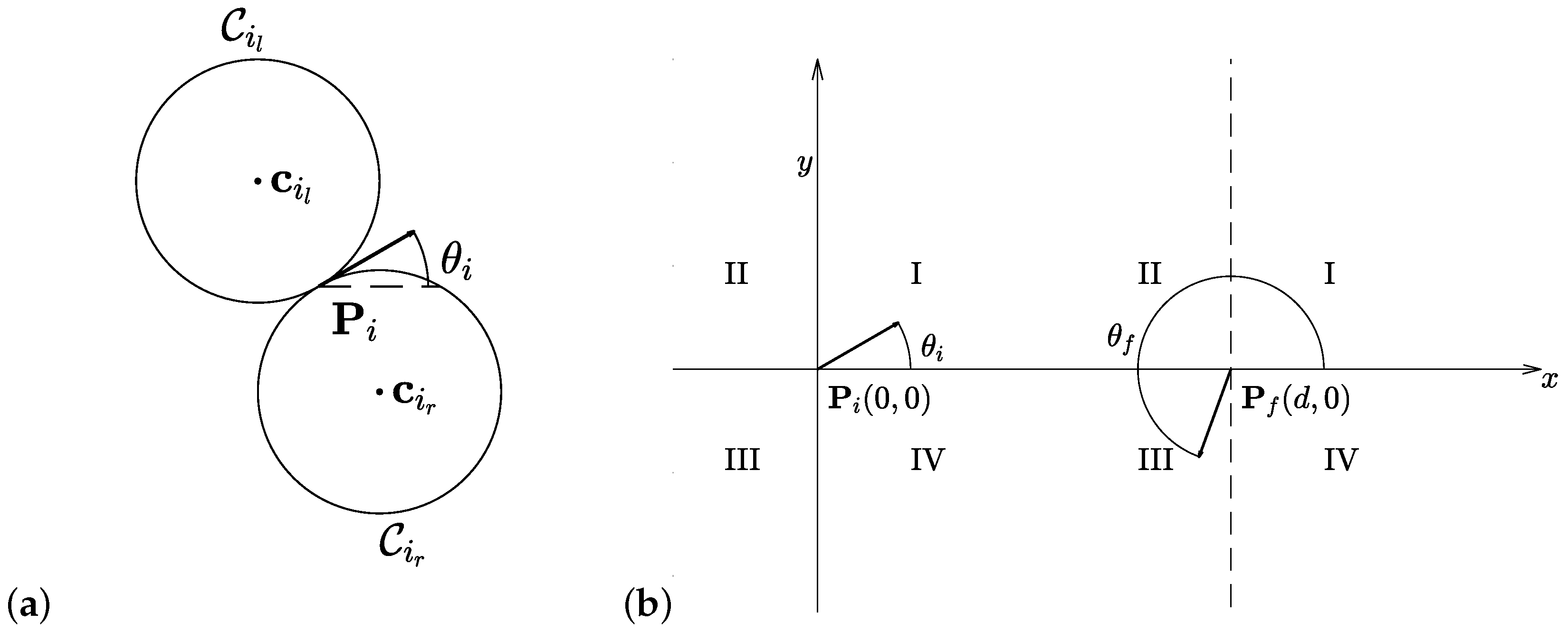

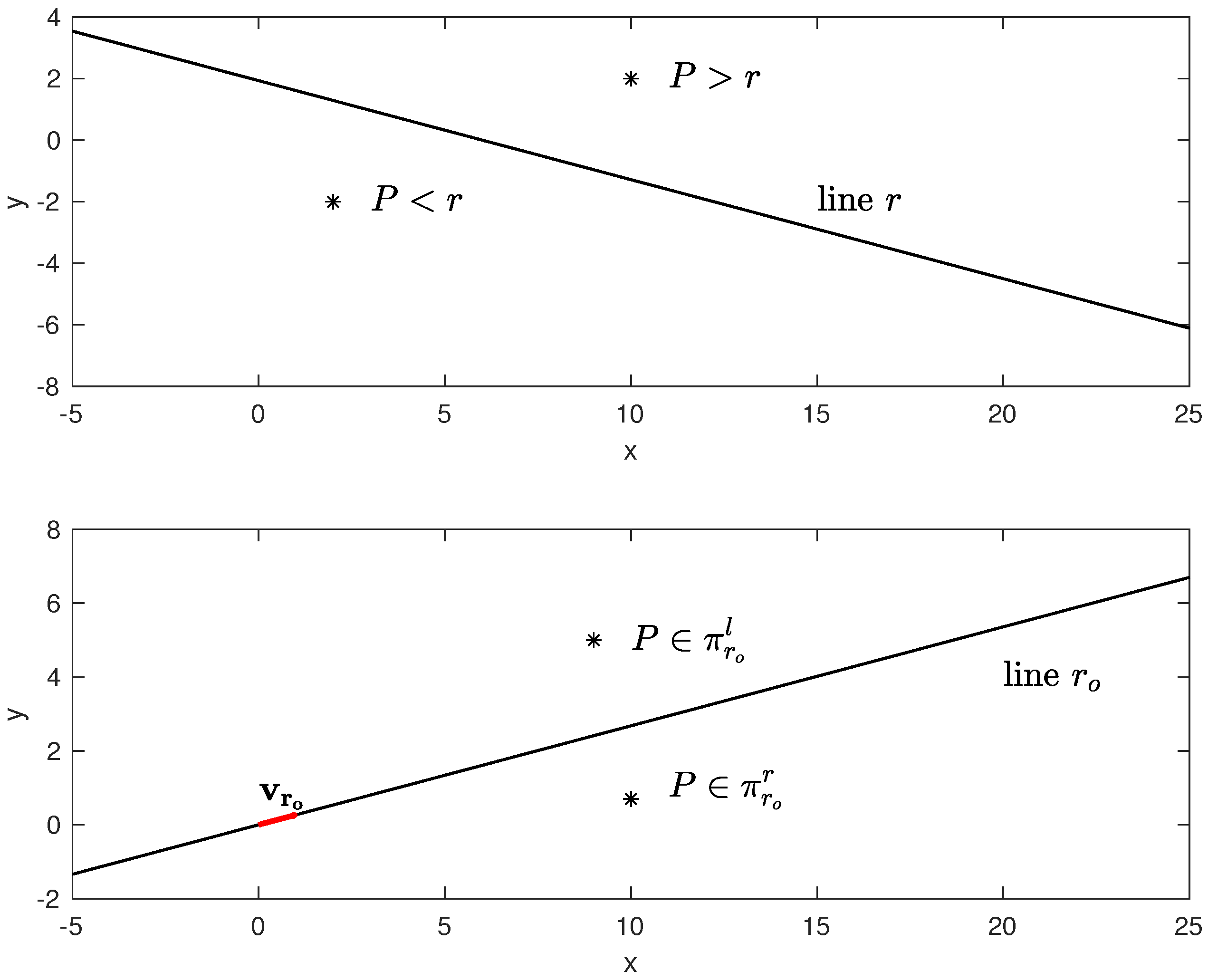

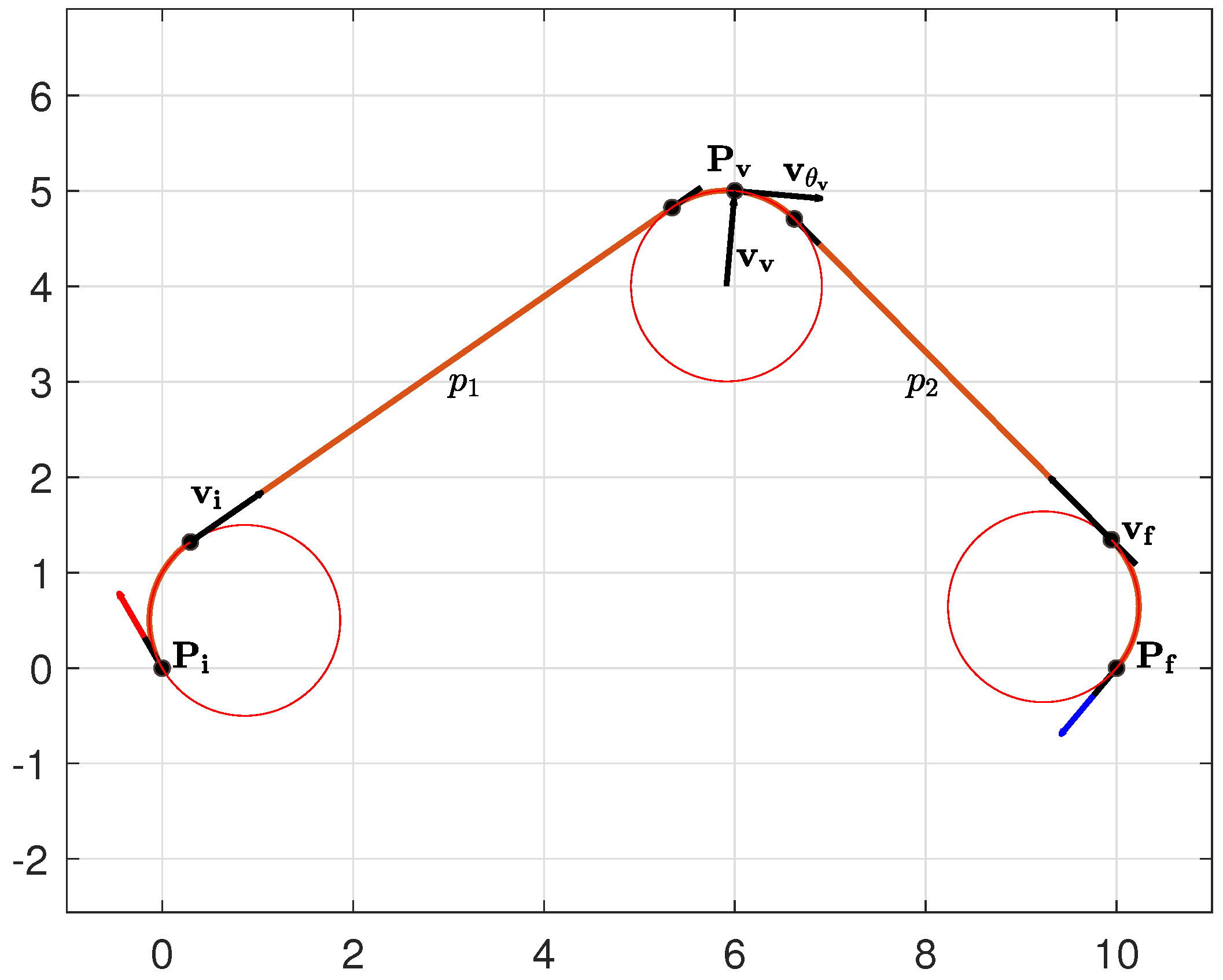
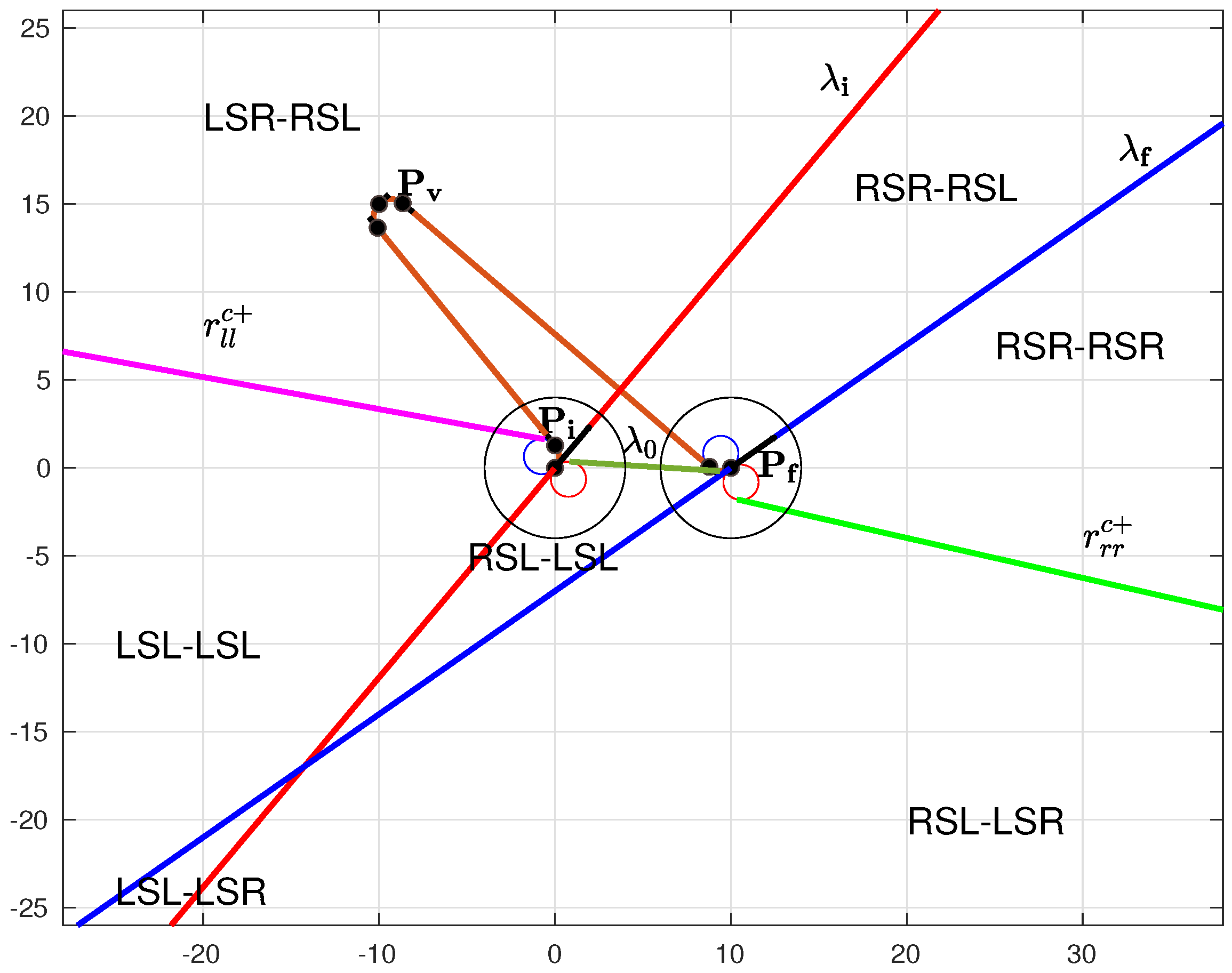

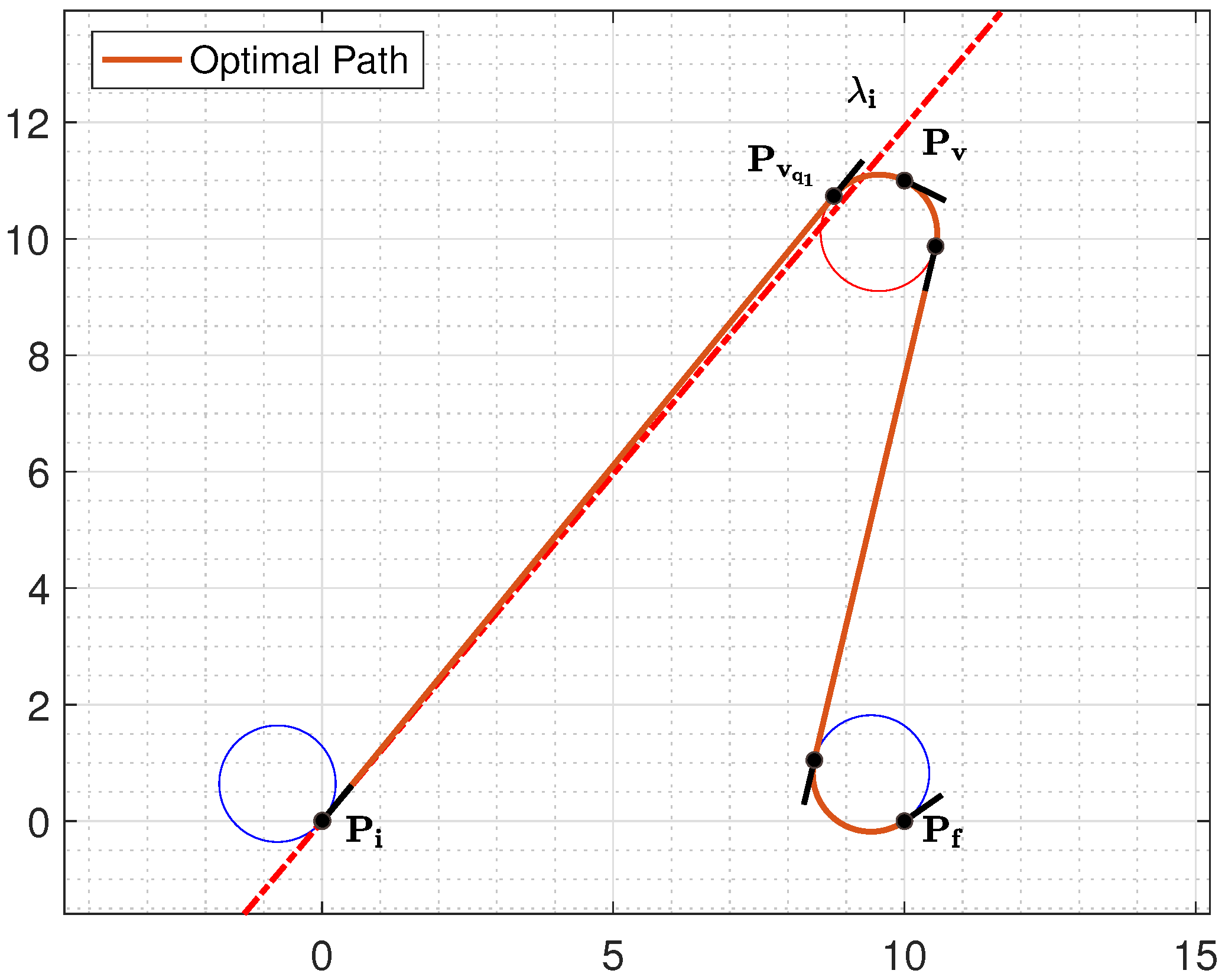
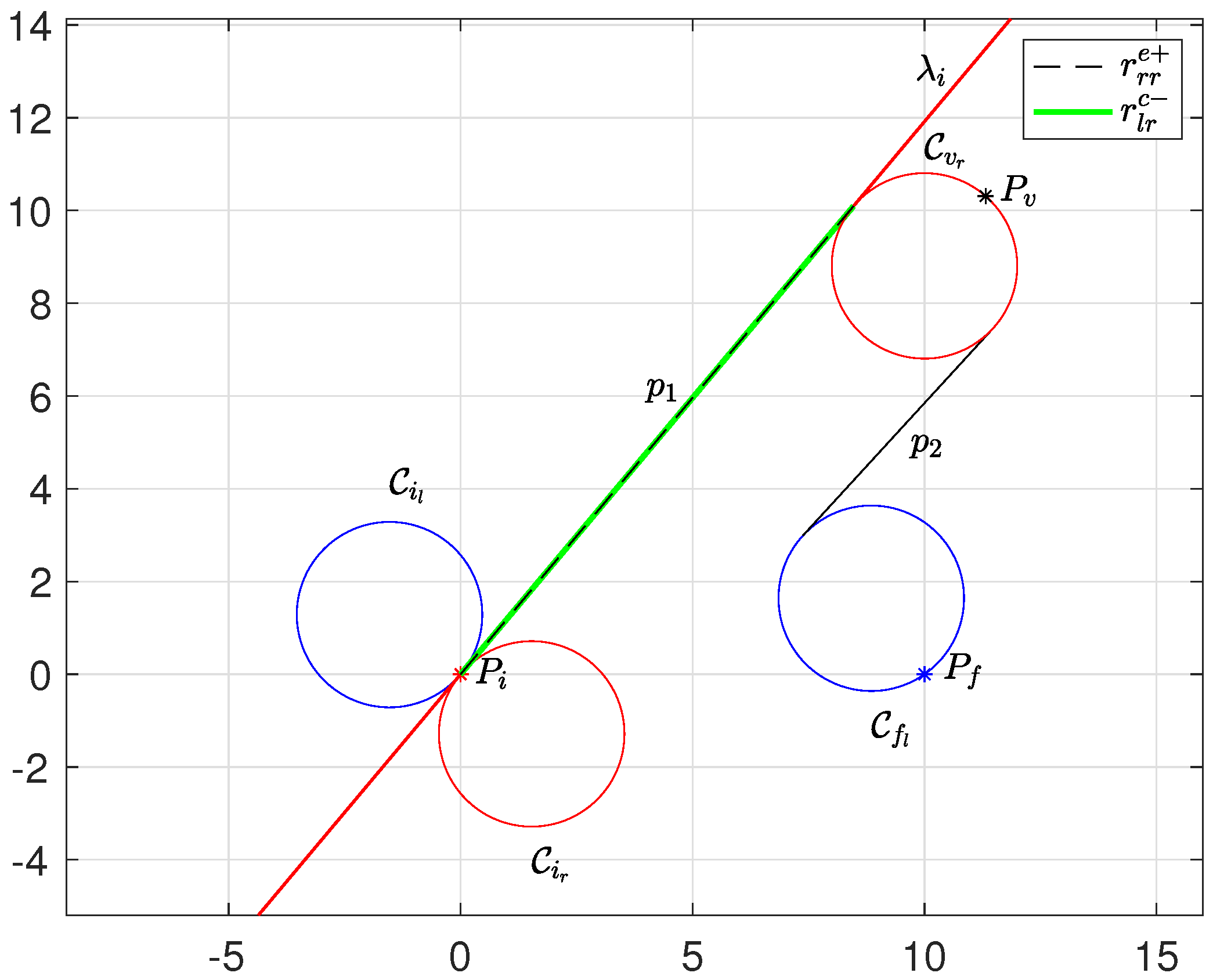
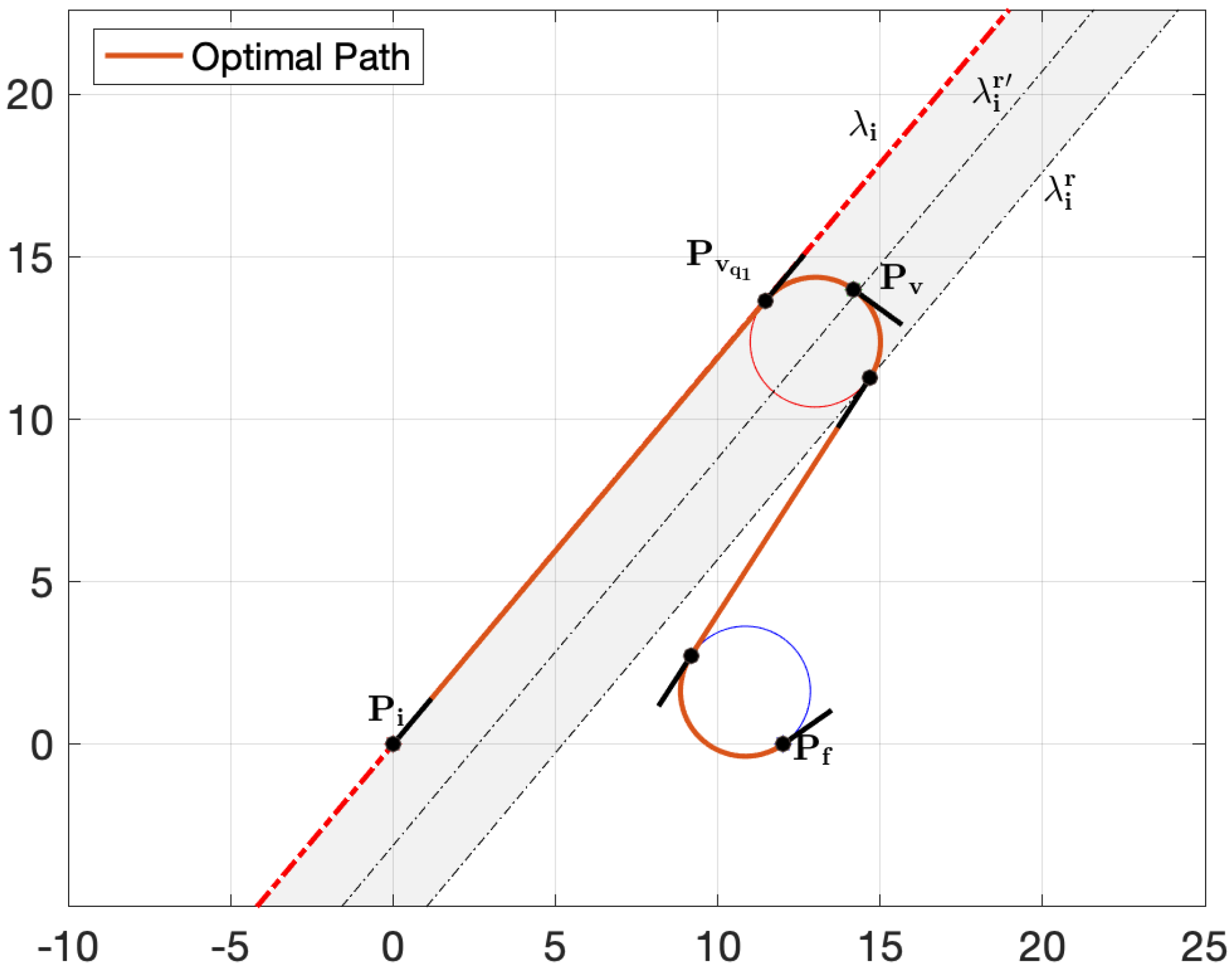
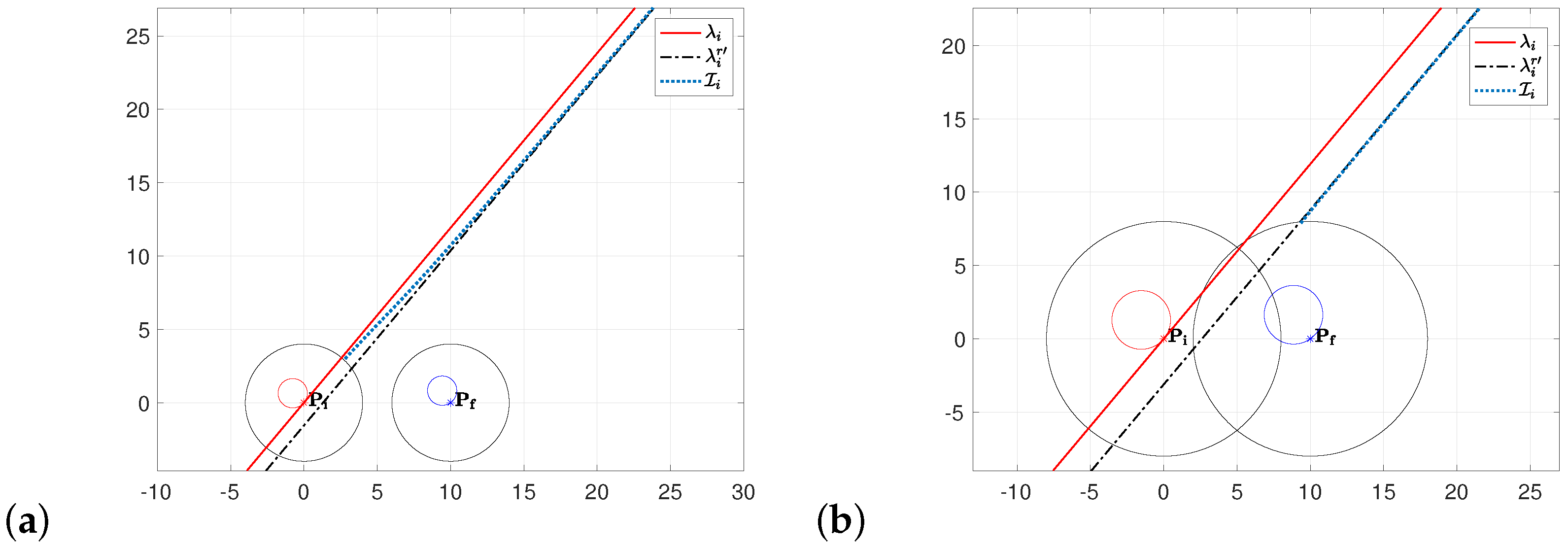

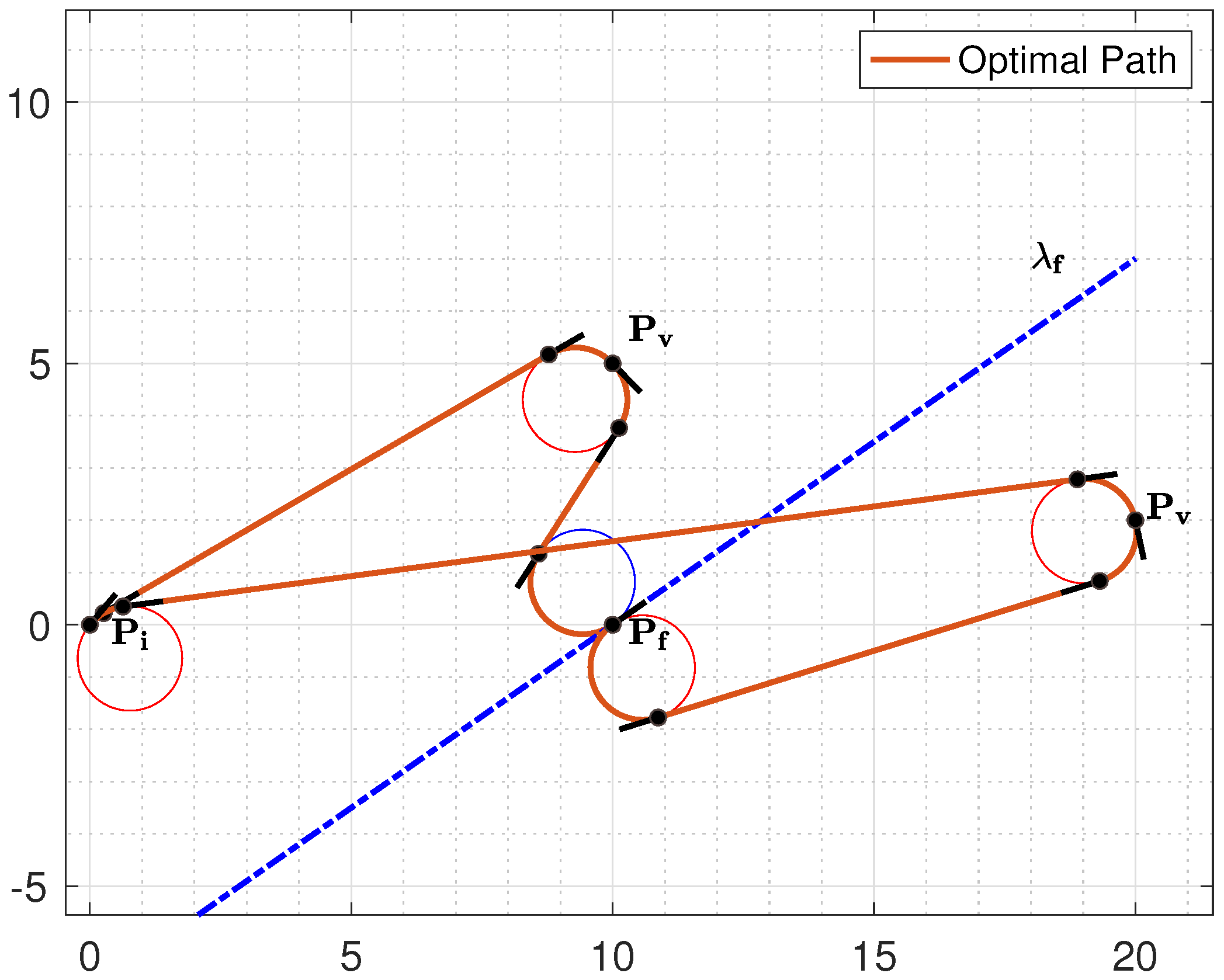
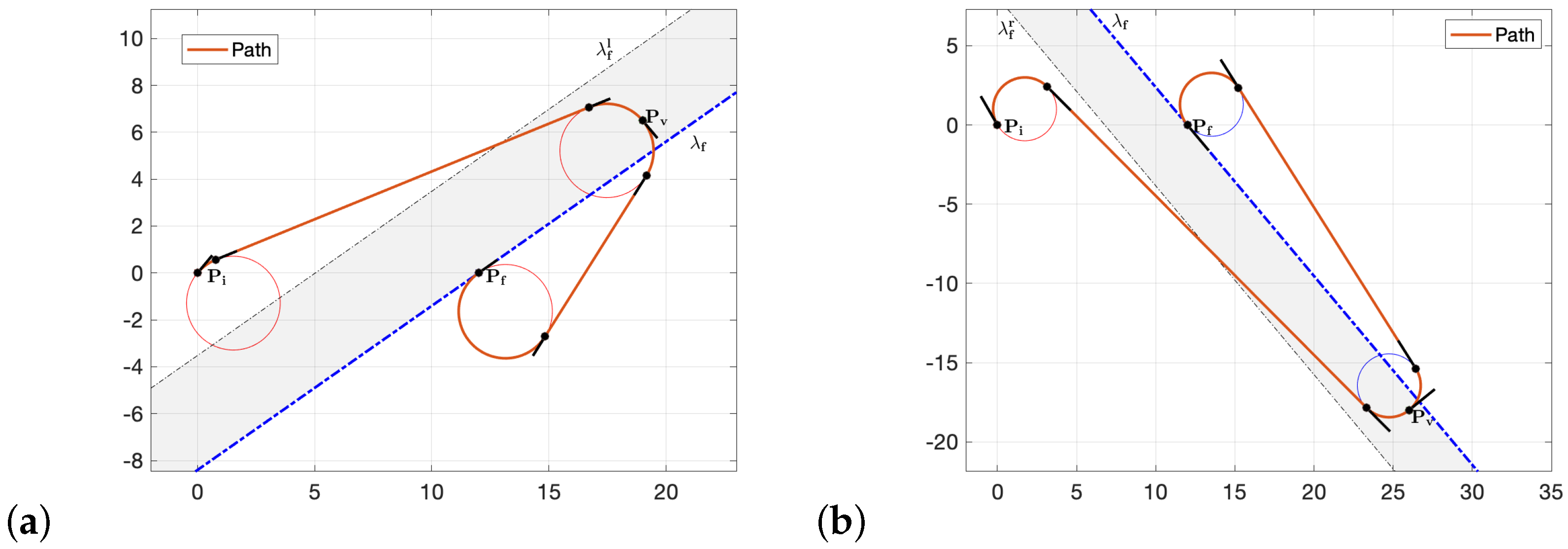
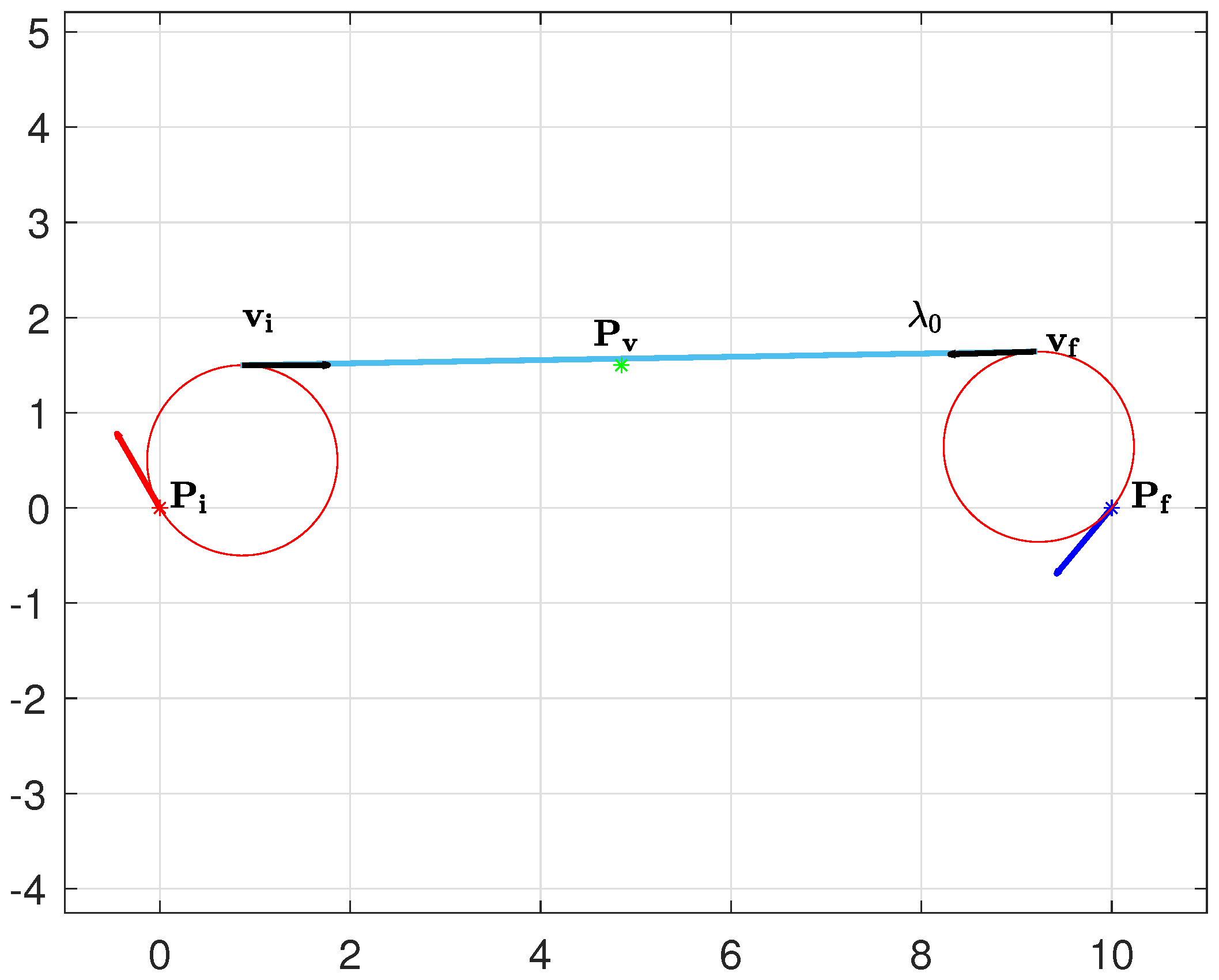


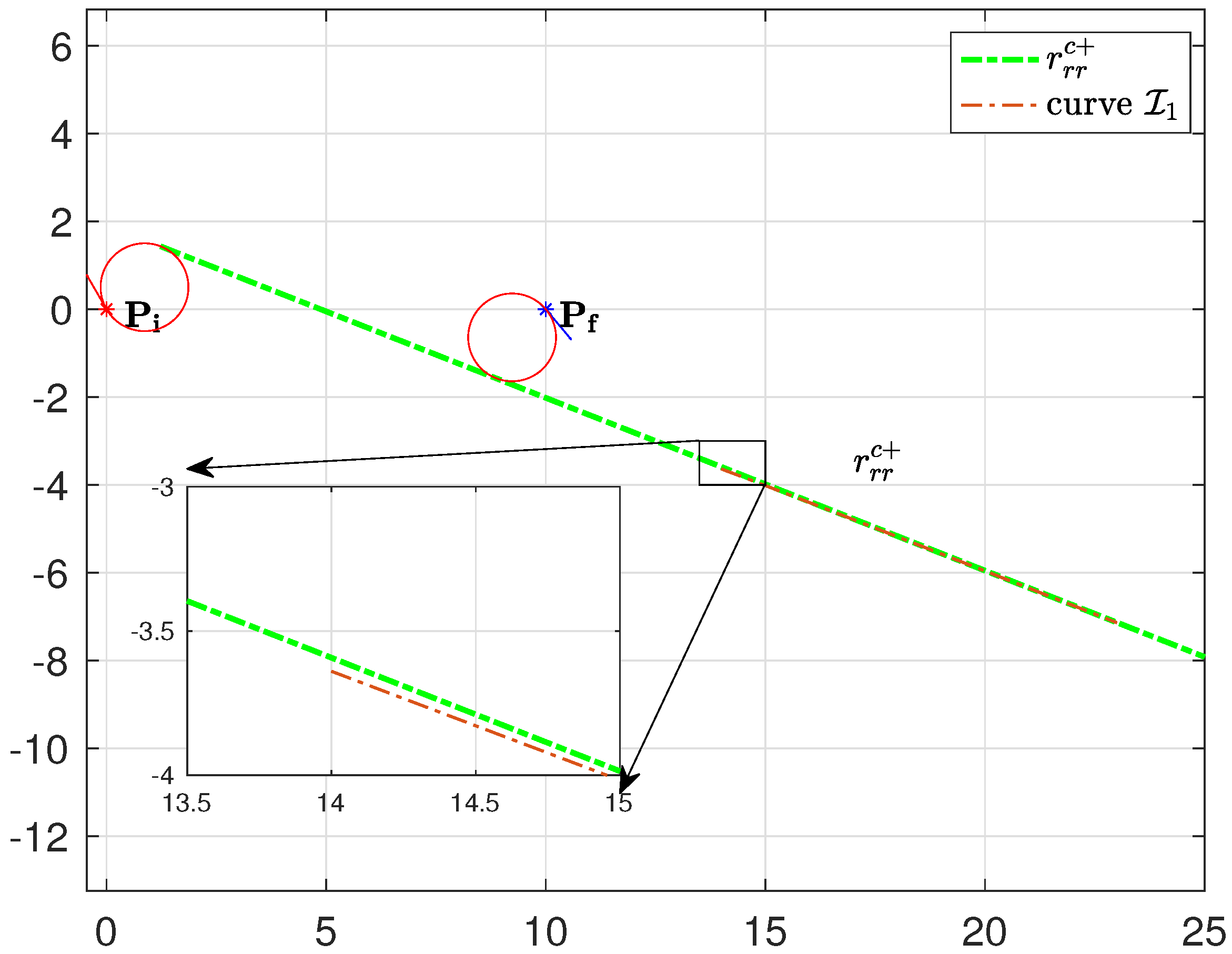
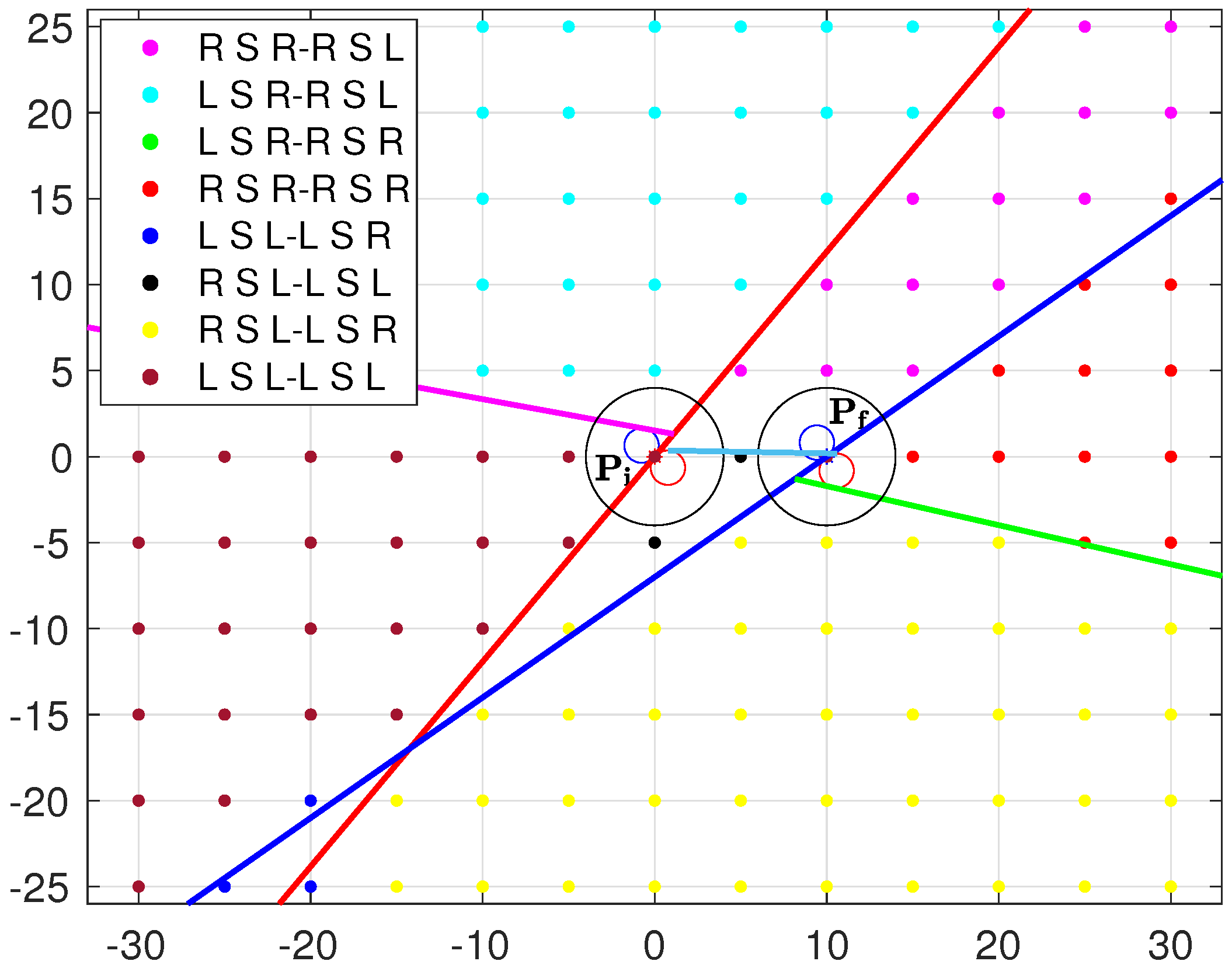
| Improvement (I) | |
|---|---|
| Classification |
Disclaimer/Publisher’s Note: The statements, opinions and data contained in all publications are solely those of the individual author(s) and contributor(s) and not of MDPI and/or the editor(s). MDPI and/or the editor(s) disclaim responsibility for any injury to people or property resulting from any ideas, methods, instructions or products referred to in the content. |
© 2024 by the authors. Licensee MDPI, Basel, Switzerland. This article is an open access article distributed under the terms and conditions of the Creative Commons Attribution (CC BY) license (https://creativecommons.org/licenses/by/4.0/).
Share and Cite
De Palma, D.; Parlangeli, G. Classification Scheme for the Three-Point Dubins Problem. Machines 2024, 12, 659. https://doi.org/10.3390/machines12090659
De Palma D, Parlangeli G. Classification Scheme for the Three-Point Dubins Problem. Machines. 2024; 12(9):659. https://doi.org/10.3390/machines12090659
Chicago/Turabian StyleDe Palma, Daniela, and Gianfranco Parlangeli. 2024. "Classification Scheme for the Three-Point Dubins Problem" Machines 12, no. 9: 659. https://doi.org/10.3390/machines12090659
APA StyleDe Palma, D., & Parlangeli, G. (2024). Classification Scheme for the Three-Point Dubins Problem. Machines, 12(9), 659. https://doi.org/10.3390/machines12090659





